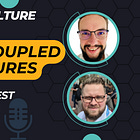📚 Book club: Domain Modeling Made Functional
Join the book Club! Set intention. Read. Learn. Apply. Or procrastinate. Your choice.
Our second call on Domain Modeling Made Functional tonight at 16:30 CEST!
I have to say I'm enjoying the book much more than I thought I would.
It's a rare breed.
One of the first DDD books—that isn't Event Storming or Modeling focused—that talks implementation but avoids the spam of object-oriented patterns.
It's a breath of fresh air. If you're on the fence on this one, I can wholeheartedly recommend it.
If you are new, welcome to 🔮 Crafting Tech Teams. I publish to you every week on how to become a better engineering leader. As a subscriber you will receive these posts straight to your favorite inbox.
Free subscribers get access to about half of each paid post and the free content related to the book club and 🏔 Our Tech Journey.
Whenever you’d like to become a paid subscriber you will receive full access to all content including early previews of books and coaching I offer.
I recommend this video by the author to get you excited about reading this material. I can assure you F# knowledge is not necessary. Bring a curious mind!
The structure of our club:
3 calls per month, 3 different times to accommodate more time zones
1st full week of the month: offline introductions, book logistics
2nd week—MON 6:30pm CEST3rd week—TUE
4pm4:30pm CEST (that’s today!)4th week—THU 6pm CEST
An accountability group and networking
A speed reading mini-workshop every few months for newcomers (this is now a paid bonus for those who express interest)
Reading will be up to your own level of commitment and accountability held and shared with the group members
For large, active groups, you’ll get a buddy assigned for accountability. Your buddy will be the best buddy for you!
Explore continuous delivery and processes of elite performing engineering cultures
Previous articles and live streams
Step 0: Join the group
The magic happens on our slack. Now over 100 strong.
Step 1: Set an Intention—Pick your Problem
The tech industry is notorious for new things. New frameworks. New languages. New code. New products. But in reality we are iterating upon fundamentals and exploring nuances that have not been tried yet.
Your intention is the same: You don’t read to create new knowledge. Reading allows you to bring nuance to what you already experiences and ideas you already have. This understanding of a new approach on what you already had in mind is what shapes a deeper knowing.
Here are some examples of intentions that are easy wins for quickly going through a book:
I want to take 1 point from the book and adapt my process to become a better leader
My team is working on an important project and we are struggling with silence. I want to improve communications in our crucial next few weeks
I want to explain the book to my team, inspire them to read it
I’m skeptical and believe I already know this—so I’ll read it to ensure I’m not being too naive about what I don’t know
I never finish books, so I want to improve on that mindset in 3 weeks with Denis and never worry about not finishing books again
The important factor is that your intention provides value to yourself and your team. It should be precise enough so that you can identify it and small enough that you can conceptualise it with a few actions.
You may explore the differences between understanding and knowing in a previous CTT issue below.
Stop Blocking your Team's Intuition
I’m a recovering left-brainer. Early in my career I thought confidence was fueled by understanding. Understanding topics. Frameworks. Languages. People. That seemed all fine and well in my head. But it didn’t bode well in the real world. I understood— but wasn’t confident in my understaning.
Step 2: Optimise your Process—Improve your reading speed and recall
I was given advice and already-bought courses for speed reading. I sat in on for over 10 years, dismissing it as “cheating”, woo-woo nonsense. Then I went on a cruise with my mentor and met my peers of fellow entrepreneurs and impostors. The knowledge density and material was packed! And I saw first-hand how someone devoured an entire book in an hour. That got me hooked.
This challenge is partly an inspiration to recreate that moment for you. Below is a summary of the advice I was given that I now got to appreciate more and understand fully:
Time-Saver: Time is precious. You aren’t always reading a steamy romance novel. You want the relevant content for you. The hidden surprises and gems. Now. And then do the important things in your life. Speed reading allows you to read and comprehend information faster.
Knowledge Amplifier: Most people read with their ears, instead of their eyes. They listen to themselves subvocalise what they skim over at low volume. The eye movements are not conscious and completely automatic.
But knowledge and understanding is more like a Picasso painting, not a meme one-liner. Imagine the difference of looking into a rich painting vs. listening to someone describe it to you?Boost Your Confidence: Get rid of that feeling of “I never finish a book!”. Read, explore, skip pages guilt-free.
Improve Focus: Speed reading techniques can help enhance your focus and concentration, enabling you to stay engaged with your reading material. It can be quite difficult at first and is definitely not a passive exercise.
Step 3: Absorb the A-ha moment you need to apply a change
Planning is half of success, as they say. Once you’re clear on your intention and have improved your process, it’s time to explore. We will go through strategies on how to best prioritise reading the book. This includes:
Things to watch out for
Topics to prioritise for your intention
Note-taking
Setting up your environment for reading
Reading with intention
The most detrimental way of reading is the attitude of “I have to get through this chapter.” That way you are optimising your attention for filtering out content and blasting through the pages instead of keeping an eye out for valuable information.
This is a bad habit and we’ll pay extra attention to it on our live calls. Active reading is closer to a treasure hunt!
Step 4: Apply the change
It’s all for naught if it ends up in your brain and you garbage collect it. Have no illusion—you will forget most of it at some point. The key to new knowledge is to ensure it leaves your brain as a byproduct of actions making old information obsolete by adding more detail to learnings. This is what makes understanding personalised, slowly shaping it into a deeper sense of knowing.
This will be the focus of our live huddles.








I enjoyed the Domain Modeling Made functional. I read "Our second call on Domain Modeling Made Functional tonight at 16:30 CEST!" which brings me to the point is there a setting on substack which converts these time-zones to my local time-zone. If not, would it be hard to mention any of the time-zones in US?